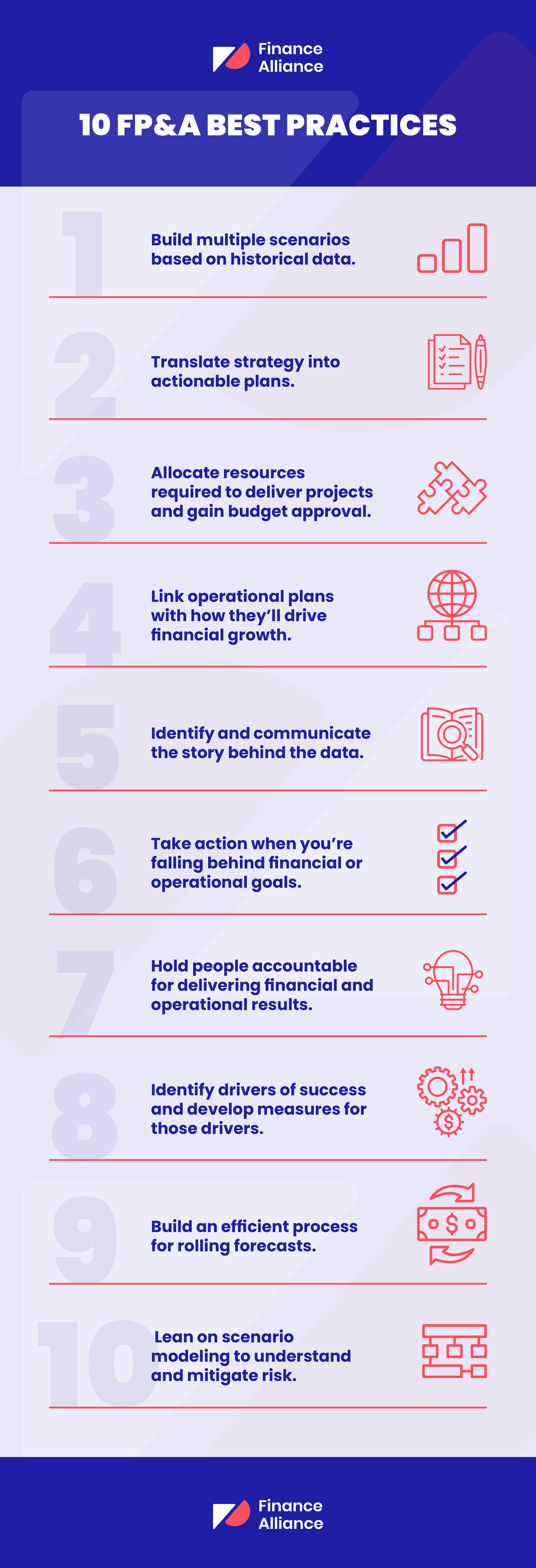What are the best practices in financial planning and analysis (FP&A)?
The best-run finance functions have mastered the art of FP&A. They’ve proved that when done right, FP&A doesn’t just predict business outcomes, it can drive them too.
Below, you’ll find our infographic detailing the top FP&A best practices to help you streamline your existing processes and transform FP&A into a strategic and effective initiative that drives distinctive business performance.
Enjoy!
10 FP&A best practices Infographic:

Here are some more details about each of the 10 FP&A best practices:
1. Build multiple scenarios based on historical data
Businesses must be equipped to face a variety of potential financial scenarios. For example, what would happen if revenue growth slowed down? Or if taxes increase drastically next year?
Scenario planning is important because it helps you understand how the business will perform in such events.
When using historical data to help map out scenarios, there are three variations of scenario analyses that can prove useful:
- Base scenario – What’ll happen if the business remains on the same growth trajectory?
- Upside scenario – What’ll happen if the business performs better than expected?
- Downside scenario – What’ll happen if the business underperforms?
2. Develop a strategy and translate it into actionable plans
Yes, FP&A is used to forecast sales and expenses, and perform the proper budget allocation. But, if you want to help transform the business into a high-performing powerhouse, you must learn to use FP&A to drive business outcomes.
The CEO and other senior members will often approach the FP&A team with high-level strategies to help drive business growth. For example, they might want help identifying areas to cut costs without damaging their reputation as the lowest-cost supplier on the market.
The FP&A team then takes that strategy and translates it into an actionable plan to make it happen. This could involve identifying opportunities to cut expenses, targets, timelines, and measurement criteria and communicating all of this to leadership.
3. Allocate resources required to deliver projects and gain budget approval
In the same way that you can’t achieve financial projections without an operational plan, you can’t pursue those plans without having the necessary resources at your disposal.
Plans won’t materialize without resources to make them happen.
Resources can take the form of both time and money, which should be allocated to the plan and/or budget. From there, the FP&A team must gain budget approval from senior management.
4. Link operational plans with how they’ll drive financial growth
Operations are intertwined with financial growth. The best-performing companies understand this and make conscious efforts to connect the two.
To help link operational plans to how they drive growth, it’s best to start with Operational Managers. While most know everything about their operations inside and out, not everyone understands their impact on the company’s profit and loss (P&L).
Therefore, connecting financial growth with operations requires educating the operations team and making sure they can correlate how their goals and actions directly impact finance.
5. Identify and communicate the story behind the data
One of the most important FP&A best practices is learning how to communicate numbers to people who can’t understand the data as quickly or as well as someone with a background in finance.
This is where variances analysis is particularly useful, especially when a business experiences an earnings shortfall. In this type of situation, an ‘inch deep’ analysis just won’t cut it. Executives and key shareholders such as investors want more than a few lines from the income statement as an explanation, they want to know exactly how the shortfall happened.
Teams that follow FP&A best practices successfully will be able to provide a thorough business understanding of the variance and do so in ways that senior management understands.
Data visualization storytelling is another effective way to convert numbers into compelling narratives that accurately depict the story behind the data. You can learn more about data visualization storytelling in the blog post below:

6. Take action when you’re falling behind financial or operational goals
Sometimes things don’t go as planned and you may find yourself dragging behind financial or operational goals. Companies that follow FP&A best practices tend to use models of agility. This essentially means they respond strategically when goals seem out of reach.
Taking action when you’re falling behind is important for obvious reasons. However, you’d be surprised to learn just how many organizations are happy to adjust their expectations downward.
In reality, when things aren’t going as planned, it’s time to evaluate what’s happened and identify the steps to get back on track.
7. Hold people accountable for delivering financial and operational results
Accountability is important. Best-in-class FP&A ties reward to achievement. In other words, when people do well, they’re rewarded for it whether that’s in the form of a salary rise, bonus, promotion, title change, etc.
Holding people accountable is powerful not just for them personally, but those around them too. When someone is held accountable for delivering results and they’re rewarded for doing so, other people take notice.
Having accountability for achieving operational targets and financial results drives productivity. This becomes even more apparent when the company provides incentives for doing so.
8. Identify drivers of success and develop measures for those drivers
One of the top financial planning and analysis best practices that successful teams follow is to identify factors that drive business success.
When a positive financial change occurs, you need to uncover the ‘why’ and take a closer look at the drivers of business success. You can assess the main drivers of success based on the logical connection between the driver and outcome and whether there was an actionable cause that manipulated the driver and can do so again.
Some examples of how FP&A professionals identify key drivers of success are searching for a logical connection between something like innovation and business growth, whether the company can manipulate the driver, and how strong the connection is between the two variances (such as innovation and increased revenue).
9. Build an efficient process for rolling forecasts
A rolling forecast uses historical data to continuously predict future numbers over a period of time. It’s an essential report that is a lot more agile than static forecasts and therefore more effective at helping senior management make sound business decisions.
If you intend to brush up on FP&A best practices going forward, we suggest that you build an effective and efficient process for rolling forecasts.
The best-performing rolling forecasts use real-time data to forecast business performance and provide insights for better scenario planning. Not only that, but when done right, a rolling forecast can also be used as a growth measurement tool, which becomes invaluable to both the finance team and leadership.
10. Lean on scenario modeling to understand and mitigate risk
Risk mitigation is a vital part of FP&A best practices, which is why the most successful teams use scenario modeling to help detect, analyze and mitigate risk.
Scenario modeling estimates the likelihood of certain situations occurring. With a scenario model, the business can put a plan in place to protect the business should any of the events actually happen.
Although it can be time-consuming to perform strategic scenario planning for outcomes that may never actually happen, it has its fair share of advantages, including:
- It helps executives understand the impact of a variety of potential events, making your life easier as an FP&A Manager who has to explain why action plans for different scenarios are necessary.
- It can take place at any level of an organization. You can use strategic scenario planning for the entire business or individual projects.
- It helps to divide resources rationally and effectively.
- It reduces risk and the impact of negative risks because it gives you the insight to prepare for them and ‘fix’ weak spots before they manifest into much bigger problems.
Learn how strategic scenario planning can prepare your business for anything in this blog post:

Join the Finance Alliance Community
Start networking with other CFOs and finance leaders today. Share ideas, ask questions, discover new talent, and grow your network within one of the most engaged communities of finance professionals in the world.
So, what are you waiting for?



 Follow us on LinkedIn
Follow us on LinkedIn




